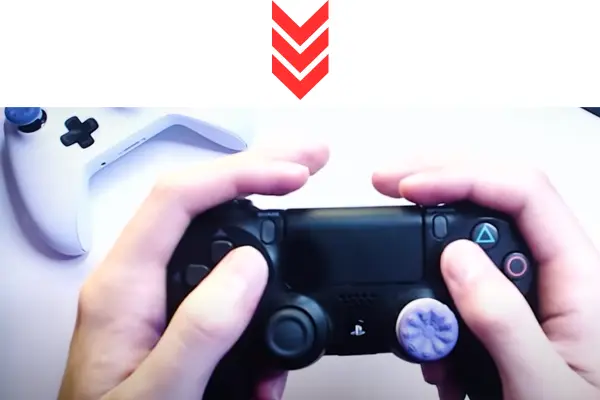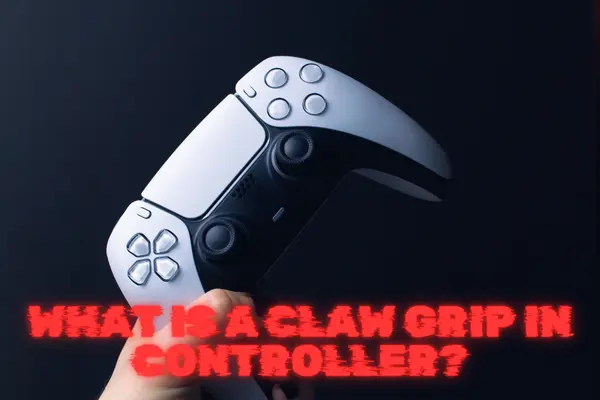What is a Claw Grip in Controller? Gaming has evolved significantly over the years, bringing forth various techniques and styles to enhance gameplay. Among these, the claw grip has emerged as a popular method for many gamers.
This technique, which involves a unique way of holding a controller, can significantly impact performance, particularly in fast-paced games.
In this article we will talk about the intricacies of the claw grip, covering everything from its definition and benefits to the types of claw grip and how to master it.
Whether you’re a seasoned gamer or a newcomer looking to improve your skills, understanding the claw grip can offer a competitive edge.
📌What is Claw Grip in Controller?

The claw grip is a method of holding a game controller where the index fingers are positioned over the face buttons, rather than the traditional placement on the bumpers.
This technique gets its name from the claw-like shape formed by the fingers. The claw grip allows players to access the face buttons without lifting their thumbs from the analog sticks, thus maintaining continuous control over character movements and camera angles.
The claw grip technique originated from the necessity for faster, more efficient button presses, particularly in high-paced games like first-person shooters (FPS) and battle royale genres.
Over time, it has become a favored grip style among competitive gamers for its ability to provide quick access to all necessary controls.
Basic Mechanics
To understand the claw grip fully, let’s break down the finger placements and mechanics:
Thumbs: Remain on the analog sticks to control movement and camera angles.
Index Fingers: Positioned over the face buttons (X, Y, A, B on Xbox or Square, Triangle, Circle, X on PlayStation) instead of the bumpers.
Middle Fingers: Rest on the bumpers and triggers.
Ring Fingers and Pinkies: Support the controller’s back for a firm grip.
This positioning allows for seamless transitions between movements and actions, a crucial advantage in competitive gaming scenarios.
📌Why Play Claw Grip?
Enhanced Gameplay
One of the primary benefits of using a claw grip is the ability to maintain control over both movement and actions simultaneously.
In fast-paced games like Call of Duty and Fortnite, this can be a game-changer. By keeping your thumbs on the analog sticks, you can aim and move without interruption, making your gameplay smoother and more responsive.
For instance, in a high-stakes firefight, the split-second delay caused by moving your thumb from the stick to the buttons can mean the difference between victory and defeat.
The claw grip eliminates this delay, allowing for faster reactions and more precise control.
Improved Efficiency
When compared to other grip styles and even professional controllers, the claw grip offers superior efficiency.
Professional controllers like the Xbox Elite can provide additional buttons and paddles, but they come with a hefty price tag and limited durability.
The claw grip, on the other hand, can be used with any standard controller, making it a cost-effective alternative.
Additionally, professional controllers often only offer a limited number of additional inputs, while the claw grip provides full access to all the face buttons without compromising thumb placement. This makes it a more versatile and practical choice for many gamers.
Skill Transferability
Mastering the claw grip is not just about improving your performance in a single game; it’s a skill that can be transferred across various games and platforms.
Whether you’re playing an FPS, a battle royale, or an action-adventure game, the muscle memory developed through claw grip can enhance your overall gaming proficiency.
As a testament to its effectiveness, many professional gamers and streamers have adopted the claw grip, showcasing its utility across different genres and gaming environments.
By learning this technique, you can ensure consistent performance regardless of the game you’re playing.
📌Types of Claw Grip
Standard Claw
The standard claw grip involves using the index finger to press the face buttons, while the thumbs remain on the analog sticks and the middle fingers handle the triggers and bumpers.
This is the most common form of claw grip and is widely used for its simplicity and effectiveness.
Double Claw
Double claw is a more advanced variation where both hands use the claw grip. This means the index fingers of both hands are positioned over the face buttons and the d-pad.
This grip is particularly useful in games that require frequent use of the d-pad or additional face buttons, providing even greater control and flexibility.
Left-Hand Claw
The left-hand claw grip is tailored for left-handed players or for games that require more frequent use of the left-side controls.
In this variation, the left index finger is used for the d-pad or other left-side buttons, while the right hand maintains a traditional grip or a right-hand claw grip.
Right-Hand Claw
Conversely, the right-hand claw grip is the most commonly used variation, where only the right index finger is used for the face buttons. This allows for precise control over actions while maintaining full thumb control over the right analog stick.
| Variation | Description | Best For |
|---|---|---|
| Standard Claw | Index finger on face buttons, thumbs on analog sticks | General gameplay |
| Double Claw | Both hands use claw grip | Games requiring frequent use of both face buttons and d-pad |
| Left-Hand Claw | Left index finger on d-pad | Left-handed players, left-side control heavy games |
| Right-Hand Claw | Right index finger on face buttons | Right-handed players, general gameplay |
| Crab/Spider/Octopus Claw | Various creative finger placements | Specialized needs, unique control setups |
Conclusion
The claw grip is more than just a way to hold a controller; it’s a technique that can transform your gaming experience. By allowing faster, more efficient control over movements and actions, the claw grip offers a significant advantage in fast-paced and competitive games. Whether you’re a casual gamer looking to improve your skills or an aspiring professional aiming for the top, mastering the claw grip can provide the edge you need.
By understanding its mechanics, exploring its variations, and committing to consistent practice, you can harness the full potential of the claw grip. Remember, like any skill, it requires time, patience, and perseverance. But with dedication, the benefits of the claw grip can elevate your gameplay to new heights.

